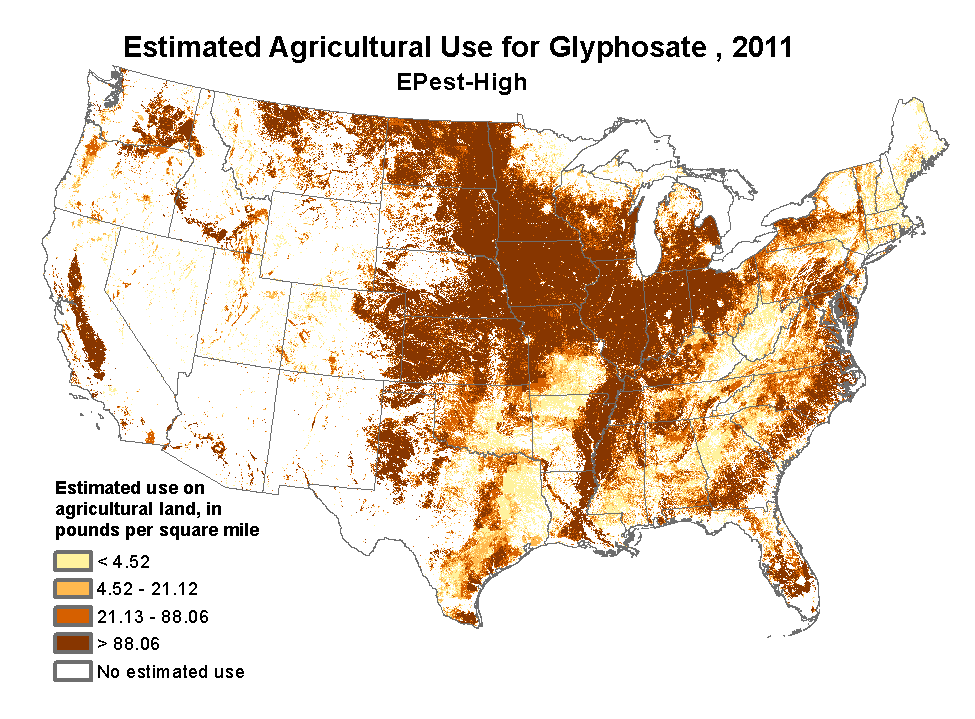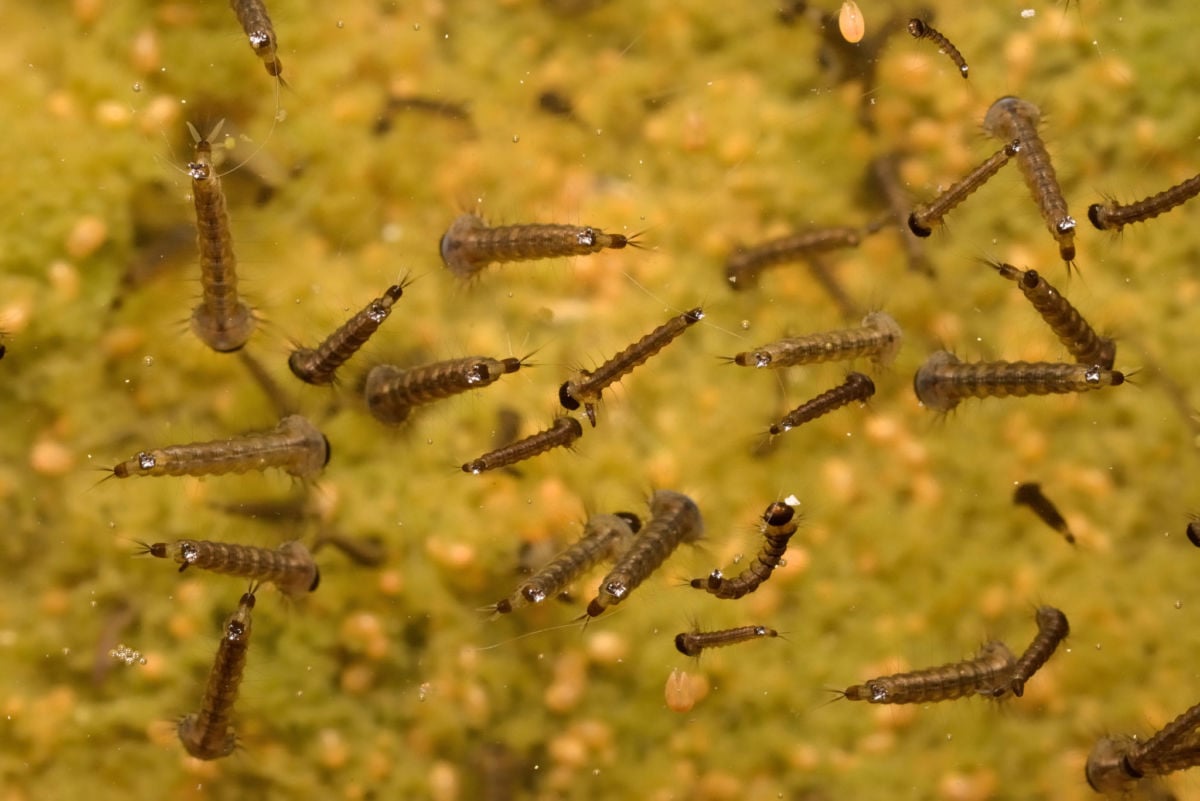As the active ingredient in Bayer’s Roundup herbicide is increasingly scrutinized for human health impacts, scientists say it also could be altering the wildlife and organisms at the base of the food chain.
Glyphosate is one of the most widely used herbicides in history. Farmers in 2014 sprayed enough of the chemical to cover every acre of cropland in the entire world with nearly a half-pound of the herbicide, according to a 2016 study published in Environmental Sciences Europe.
Long thought to be relatively benign to non-target plants and animals, evidence is growing that glyphosate, the active ingredient of Roundup, may impact the metabolism, growth and reproduction of aquatic creatures and could be altering the essential gut bacteria of animals such as bees.
Such impacts could have serious unexpected impacts on the tiny critters that form the base of the animal food chain, say environmental researchers, who warn the ecological impacts are likely to grow as glyphosate levels build up in the environment.
“No herbicide in the history of the world has ever been used this heavily. It’s a completely unprecedented case,” Charles Benbrook, an agricultural economist and author of the 2016 study, told EHN.
Ecological Impacts Emerge
Glyphosate has been used as a broad-spectrum herbicide, meaning it kills all vegetation it’s sprayed on, since the 1970s. Its use at the outset, however, was limited. Farmers and land managers could only spray it where they wanted to kill all vegetation, for instance, between the rows in orchards or vineyards, in industrial yards, or along train tracks or powerline rights of way.
That all changed in 1996, when the Missouri-based agrochemical company Monsanto (now part of the pharmaceutical giant Bayer) introduced glyphosate-tolerant crops — first corn, then soybeans, cotton and others. Farmers could spray it on and around their fields without accidentally killing their crops.
The chemical soon became the most heavily used herbicide in history.
Global glyphosate use has risen nearly 15-fold since the mid-90s, with an estimated 19 percent of global use happening in the U.S. alone.
Since this change, much has been made about the potential health impacts to humans from widespread use. In 2015, the World Health Organization classified glyphosate as “probably carcinogenic to humans” due to a growing body of research linking glyphosate to non-Hodgkin lymphoma and other cancers.
In August, a U.S. groundskeeper won a landmark lawsuit against Monsanto, saying his deadly form of non-Hodgkin lymphoma was due to years of exposure to the company’s herbicide. Monsanto and its German owner Bayer now face more than 9,000 similar lawsuits. The company repeatedly has maintained there is no link between glyphosate and cancer.
Numerous studies in laboratory animals, too, have suggested the chemical may have reproductive effects at levels considered safe by the U.S. Environmental Protection Agency.
However, at the time it was introduced, glyphosate was considered a lot safer than other broad-spectrum herbicides, such as paraquat — which could cause deadly poisoning if breathed in or swallowed. Glyphosate, on the other hand, was considered “practically non-toxic” by the U.S. Environmental Protection Agency.
That’s because glyphosate kills plants by blocking a step in a series of chemical reactions, called the shikimate pathway. Plants use this pathway to make the nutrients they need for growth. Animals and humans don’t have this pathway. We get our essential nutrients, instead, from the foods we eat.
“If you gave me a compound that inhibits a pathway not present in animals — without knowing anything else about the compound — I would not expect that compound to be very toxic to animals,” Nico van Straalen, an ecotoxicologist at Free University Amsterdam in the Netherlands, told EHN.
In addition to the increasing evidence the herbicide may harm human health, this supposed non-toxicity doesn’t square with the effects that van Straalen and other environmental researchers have observed on tiny organisms at the base of the food chain.
The Food and Agriculture Organization of the United Nations first expressed concern about the food chain effects of glyphosate in 2005, after research showed that glyphosate residues can stick around in water and soil for several months, maybe even years. That means it has the potential to build up to higher levels in the environment with each use.
In aquatic and terrestrial environments, researchers have linked changes in metabolism, growth, behavior and reproduction of certain fishes, mollusks and insects with exposure to glyphosate-containing herbicides.
A recent study by researchers in France, for instance, showed that mosquito larvae dosed with glyphosate amounts similar to those found in the environment learned the difference between dangerous and non-dangerous shadows in the water slower than larvae not dosed with glyphosate. Mosquito larvae are an important food source for many bird, fish, and amphibian species.
Those dosed with glyphosate were slower to habituate to a non-threatening shadow, which means they wasted too much energy diving below the surface when they didn’t need to — a behavior linked with larval deaths. The findings, published in 2018 in the journal Environmental Pollution, weren’t the first to suggest cognitive impacts of glyphosate to insect species.
Studies in bees have suggested that glyphosate may affect their learning and increases how much time it takes them to find their hives — impacts that could have long-term consequences for colony health.
Several experiments with mussels, crayfish and other aquatic invertebrates, to date, have showed that exposure to Roundup or glyphosate can induce a slew of changes to cellular metabolic and reproductive pathways.
However, it’s not yet clear what these changes mean for the health of invertebrate populations in the wild.
Researchers can’t entirely explain these associations. Some experts say that additional chemicals in glyphosate mixtures, called adjuvants, that help improve herbicide activity, may be partially to blame. Studies in human cell lines suggest that adjuvants found in some Roundup formulations may be more toxic than the glyphosate active ingredient itself, though studies on the effects of adjuvants in wildlife are lacking.
Others suspect that glyphosate may target biochemical pathways that we don’t yet know about.
Little research has been done to assess the effects of glyphosate on the microscopic bacteria and algae — the autotrophs at the base of all aquatic and terrestrial food chains.
Messing with the base of the food chain, say environmental researchers, could have profound ecological effects.
Microbial Consequences
Some clues are starting to emerge that investigating the effects of glyphosate on microorganisms may be key to understanding its environmental effects.
“We’ve barely begun to investigate the microbiomes of animals and soil as possible targets for glyphosate toxicity,” van Straalen said.
Some of the bacteria and fungi that form the invisible scaffolding of our ecosystems use the shikimate pathway — the same series of chemical reactions that glyphosate blocks — to produce essential nutrients.
Two studies in 2018 found that glyphosate could be harming honey bees by targeting the specialized bacteria that honey bees harbor in their gut. These bacteria use the shikimate pathway, so researchers hypothesized they may be susceptible to glyphosate’s effects. They think these bacteria may be involved in helping the honey bee immune system fight off infection.
“One effect is that disruption of the microbiota by glyphosate seems to make the bees more susceptible to opportunistic pathogens,” Nancy Moran, a bee researcher at the University of Texas at Austin, told EHN. She is a senior author of one of the bee studies, published in the Proceedings of the National Academy of Sciences, last September.

Moran and her colleague at UT Austin, Erick da Silva Motta, said it’s too soon to know whether glyphosate could be having similar impacts on the gut bacteria of other animal species. Aside from a few studies in earthworms and ruminant farm animals, few studies have looked at potential effects of the chemical on the microbiome. “Gut bacteria have different roles and different levels of importance in different species,” Moran told EHN.
One of the main challenges in studying the effects of glyphosate on animals such as bees is that we don’t really know how often and how much they are exposed to the herbicide in real life after it is sprayed in a field. That’s important information to have when trying to set up experiments that test realistic exposure scenarios, da Silva Motta told EHN.
Some scientists worry about the effects that glyphosate may have on soil microbes. Many bacteria and fungi in the soil environment are sensitive to glyphosate, but some are naturally resistant, Maria Finckh, a plant pathologist at the University of Kassel in Germany, told EHN.
That means certain microbes might survive better than others under heavy glyphosate use. Soil microbes play a huge role in essential Earth processes such as carbon and nutrient cycling. Any selective pressure that might limit the ability of soils to carry out these important functions could have serious environmental ramifications, Finckh and others have warned.
A Problem of Scale
The environmental impacts that researchers are beginning to link to glyphosate and glyphosate-based herbicides may indicate a major problem with the scale at which we’ve applied the herbicide, Benbrook said.
There’s an old saying in toxicology: “The dose makes the poison.” It speaks to the tenet that all chemical substances — even water or oxygen — can be toxic if there’s too much of it for a biological system to handle. It’s possible that the environmental effects we are beginning to see with glyphosate-based herbicides have a lot more to do with the amount of the stuff we’ve put into the environment than the intrinsic toxicity of the chemical, he explained.
“It’s probable this would have happened with whatever herbicide had been associated with the [genetically engineered] crop revolution. It just happened to be glyphosate,” he said.
Join us in defending the truth before it’s too late
The future of independent journalism is uncertain, and the consequences of losing it are too grave to ignore. To ensure Truthout remains safe, strong, and free, we need to raise $46,000 in the next 7 days. Every dollar raised goes directly toward the costs of producing news you can trust.
Please give what you can — because by supporting us with a tax-deductible donation, you’re not just preserving a source of news, you’re helping to safeguard what’s left of our democracy.
